Podcast: Play in new window | Download
Subscribe: Apple Podcasts | RSS
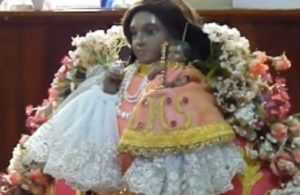 The year 1660 saw a great plague hit the western region of the province of Nueva Galicia in the Viceroyalty of New Spain. In the remote mountainous area of what is now the Mexican state of Jalisco, thousands of people died over the course of a few months. Desperate for an end to the sickness, groups of people banned together to make a pilgrimage to the small mining town of Talpa. For many decades the church there had been the home of a statue of a very powerful Virgin and many who had put their faith in her and made offerings before her had received unbelievable miracles. Groups of pilgrims arrived petitioning the Virgin for relief from the plague and within three days they received what the asked for: no more people died and there was no more sickness in the land. Little known outside the immediate area, after the cessation of the plague the Virgin of Talpa became known throughout New Spain and began receiving pilgrims from hundreds of miles away. The miracle of the ending of the 1660 plague was not the first unbelievable event connected with this statue, which is of the Madonna and Child done in the manner of the Virgin of the Rosary. Her history of miracles begins several decades earlier.
The year 1660 saw a great plague hit the western region of the province of Nueva Galicia in the Viceroyalty of New Spain. In the remote mountainous area of what is now the Mexican state of Jalisco, thousands of people died over the course of a few months. Desperate for an end to the sickness, groups of people banned together to make a pilgrimage to the small mining town of Talpa. For many decades the church there had been the home of a statue of a very powerful Virgin and many who had put their faith in her and made offerings before her had received unbelievable miracles. Groups of pilgrims arrived petitioning the Virgin for relief from the plague and within three days they received what the asked for: no more people died and there was no more sickness in the land. Little known outside the immediate area, after the cessation of the plague the Virgin of Talpa became known throughout New Spain and began receiving pilgrims from hundreds of miles away. The miracle of the ending of the 1660 plague was not the first unbelievable event connected with this statue, which is of the Madonna and Child done in the manner of the Virgin of the Rosary. Her history of miracles begins several decades earlier.
Spanish conquistador Nuño de Guzmán first came to the region in the 1530s. His conquest of the various indigenous groups of Nueva Galicia was so violent that the region remained in a state of unrest for many years. The area around modern-day Talpa was part of a chiefdom ruled by Nahua people who were loosely related to the Aztecs but were not controlled by the Aztec Empire. Nestled high in the mountains, among forests of pine, walnut and maple, the original name of Talpa was Tlalpan, a Nahuatl name combining the words tlalli, meaning “land” and pan, “above” or “atop.” Captains of Nuño de Guzmán, Juan and Cristóbal de Oñate and Juan Fernández de Híjar came to the region of Tlalpan in 1540 and subjugated it peacefully. Spanish settlers began arriving almost immediately, attracted to local mineral resources, and by 1585 a small Spanish town grew up near the original indigenous settlement. By 1599, the royal authorities in Guadalajara formally 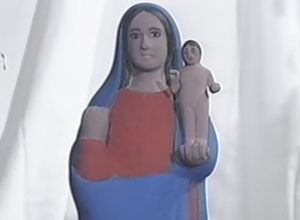 recognized the town and christened it Santiago de Talpa. The town fell under the administration of the nearby municipality of Guachinango. Father Manuel de San Martín arrived at Talpa sometime in the 1570s or 1580s and he brought with him a statue of the Virgin of the Rosary. An anonymous native artist from the Lake Pátzcuaro region fashioned the statue out of corn paste as was customary at the time. The Virgin had a beautiful face and intricate details and the townsfolk built a small chapel for her and two other religious items: a statue of Santiago and wooden carving of Christ on the cross. In the early 1600s the Spanish miners abandoned the town and many of the buildings fell into disrepair. In one version of the Virgin of Talpa story, an indigenous family took the three religious pieces from the small chapel and kept them among family members in different places. In another version of the story before the chapel was abandoned the pieces were buried under some floorboards. In September of 1644 with more people moving into the area the Church assigned Pedro Rubio Félix to minister to the small town of Talpa and stationed him in the nearby town of Guachinango. One of Father Félix’s first tasks in Talpa was to reverse some four decades of neglect and restore the chapel. He started renovations immediately and ordered the return or the exhumation of the three religious artifacts previously used in the chapel. When the Spanish priest examined the items, he assigned local artisans to refurbish the pieces. The wooden Christ and the wooden statue of Santiago only needed minor repairs. The Virgin, however, made of the more delicate corn paste, needed a major overhaul. The statue had been nearly destroyed by worms and her clothing eaten by moths. Some considered her a total loss.
recognized the town and christened it Santiago de Talpa. The town fell under the administration of the nearby municipality of Guachinango. Father Manuel de San Martín arrived at Talpa sometime in the 1570s or 1580s and he brought with him a statue of the Virgin of the Rosary. An anonymous native artist from the Lake Pátzcuaro region fashioned the statue out of corn paste as was customary at the time. The Virgin had a beautiful face and intricate details and the townsfolk built a small chapel for her and two other religious items: a statue of Santiago and wooden carving of Christ on the cross. In the early 1600s the Spanish miners abandoned the town and many of the buildings fell into disrepair. In one version of the Virgin of Talpa story, an indigenous family took the three religious pieces from the small chapel and kept them among family members in different places. In another version of the story before the chapel was abandoned the pieces were buried under some floorboards. In September of 1644 with more people moving into the area the Church assigned Pedro Rubio Félix to minister to the small town of Talpa and stationed him in the nearby town of Guachinango. One of Father Félix’s first tasks in Talpa was to reverse some four decades of neglect and restore the chapel. He started renovations immediately and ordered the return or the exhumation of the three religious artifacts previously used in the chapel. When the Spanish priest examined the items, he assigned local artisans to refurbish the pieces. The wooden Christ and the wooden statue of Santiago only needed minor repairs. The Virgin, however, made of the more delicate corn paste, needed a major overhaul. The statue had been nearly destroyed by worms and her clothing eaten by moths. Some considered her a total loss.
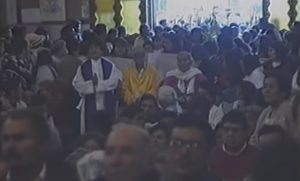 The stories of what happened next diverge once again. In one version of the Our Lady of Talpa story, the damage to the statue was so extensive that she needed to be taken to a faraway village to be repaired by an elderly master indigenous artisan who was familiar with the old ways of making figures from corn paste. It took days to deliver the Virgin to the old artisan but on the day after he completed work on the statue, she was miraculously back in the chapel at Talpa, occupying her former space on a small altar table but now in flawless condition. Believers in this history claim that the Virgin was either transported back to her home in a flash of divine light or that she ran to Talpa herself. The second version of the story has actual written documentation attached to it, with witness testimonies taken down by representatives of the royal authorities in Guadalajara who came to Talpa after hearing what happened. In this version, an indigenous woman named Maria Tenache was charged with taking the deteriorated figure of the Virgin to another village to have it worked on. When María tried to pick up the statue, it emitted a flash of light so powerful that it knocked her over. A half dozen witnesses in the chapel at the time described what happened next: the small room filled with a warm, bright light and near the ceiling appeared swirling clouds and small flying angels. It was as if the witnesses were looking straight up to heaven itself. María regained consciousness after the intense light subsided and in the place of the worm-eaten corn paste figure of the Virgin of the Rosary stood a colorfully painted duplicate made from a hard cedarwood. Many in the town heard thunderous noises during this event and many people ran to the chapel to see what happened. Word of the statue’s transformation soon left the town and the next day Father Félix visited Talpa from his permanent residence at Guachinango. The priest came with three other men to examine the Virgin. A member of the party remarked that the face and hands of the Virgin felt like human flesh and to test whether what he was feeling was actual living material, he took a candle and burned the Virgin’s right cheek. A burn mark in the same place exists on Our Lady of Talpa to this day. The priest lit candles and led the faithful present in hours of prayer. The two candles on the small altar remained intact for three days, burning but never going down. The anomalies associated with what happened in this small chapel eventually got the attention of the royal Audencia in Guadalajara and the visit of officials produced the formal documentation of the event. The transformation of the statue is known formally as El Milagro de la Renovación, or the Miracle of the Renewal.
The stories of what happened next diverge once again. In one version of the Our Lady of Talpa story, the damage to the statue was so extensive that she needed to be taken to a faraway village to be repaired by an elderly master indigenous artisan who was familiar with the old ways of making figures from corn paste. It took days to deliver the Virgin to the old artisan but on the day after he completed work on the statue, she was miraculously back in the chapel at Talpa, occupying her former space on a small altar table but now in flawless condition. Believers in this history claim that the Virgin was either transported back to her home in a flash of divine light or that she ran to Talpa herself. The second version of the story has actual written documentation attached to it, with witness testimonies taken down by representatives of the royal authorities in Guadalajara who came to Talpa after hearing what happened. In this version, an indigenous woman named Maria Tenache was charged with taking the deteriorated figure of the Virgin to another village to have it worked on. When María tried to pick up the statue, it emitted a flash of light so powerful that it knocked her over. A half dozen witnesses in the chapel at the time described what happened next: the small room filled with a warm, bright light and near the ceiling appeared swirling clouds and small flying angels. It was as if the witnesses were looking straight up to heaven itself. María regained consciousness after the intense light subsided and in the place of the worm-eaten corn paste figure of the Virgin of the Rosary stood a colorfully painted duplicate made from a hard cedarwood. Many in the town heard thunderous noises during this event and many people ran to the chapel to see what happened. Word of the statue’s transformation soon left the town and the next day Father Félix visited Talpa from his permanent residence at Guachinango. The priest came with three other men to examine the Virgin. A member of the party remarked that the face and hands of the Virgin felt like human flesh and to test whether what he was feeling was actual living material, he took a candle and burned the Virgin’s right cheek. A burn mark in the same place exists on Our Lady of Talpa to this day. The priest lit candles and led the faithful present in hours of prayer. The two candles on the small altar remained intact for three days, burning but never going down. The anomalies associated with what happened in this small chapel eventually got the attention of the royal Audencia in Guadalajara and the visit of officials produced the formal documentation of the event. The transformation of the statue is known formally as El Milagro de la Renovación, or the Miracle of the Renewal.
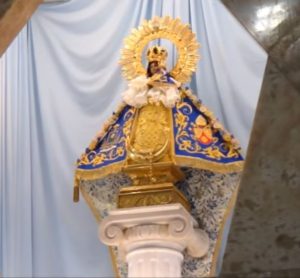 In 1649 Father Félix began supervising the building of a new church to replace the small and often crowded chapel. The larger structure, called La Nueva Iglesia de Nuestra Señora del Rosario, opened on September 19, 1651. Nine years after the building of the new church and after the ending of the plague, church officials ordered a replica of the miraculous statue to be built. Because of the popularity of the Virgin in the region the replica was called “La Peregrina,” or “The Pilgrim,” in English, and she traveled from village to village going to those people who could not make the journey to see the original Virgin in the town of Talpa. Even with the traveling duplicate version of the statue alleviating some of the numbers of visitors to the small town, the popularity of the Virgin grew, and pilgrims began arriving from all parts of New Spain, even from as far away as the modern-day American Southwest, to ask the Virgin for assistance with a variety of life’s woes. By 1670, the Archbishop ordered an even larger structure to be built at Talpa to accommodate the faithful and by 1672 the new grander church was completed just in time for the Virgin’s feast day.
In 1649 Father Félix began supervising the building of a new church to replace the small and often crowded chapel. The larger structure, called La Nueva Iglesia de Nuestra Señora del Rosario, opened on September 19, 1651. Nine years after the building of the new church and after the ending of the plague, church officials ordered a replica of the miraculous statue to be built. Because of the popularity of the Virgin in the region the replica was called “La Peregrina,” or “The Pilgrim,” in English, and she traveled from village to village going to those people who could not make the journey to see the original Virgin in the town of Talpa. Even with the traveling duplicate version of the statue alleviating some of the numbers of visitors to the small town, the popularity of the Virgin grew, and pilgrims began arriving from all parts of New Spain, even from as far away as the modern-day American Southwest, to ask the Virgin for assistance with a variety of life’s woes. By 1670, the Archbishop ordered an even larger structure to be built at Talpa to accommodate the faithful and by 1672 the new grander church was completed just in time for the Virgin’s feast day.
The Basilica of Our Lady of the Rosary, also known as the Basilica of Our Lady of Talpa, today dominates the town of 15,000 and receives millions of visitors per year, mostly from the state of Jalisco and the states surrounding it. Although popular in Mexico, many outside the country have never heard of the Virgin of Talpa, known colloquially as “La Chaparrita.” Typical of similar Mexican religious destinations, the town caters to pilgrims with curio sellers and a general carnival atmosphere surrounding the basilica. The faithful honor Our Lady of Talpa several times per year. The first day is February 2, for the Catholic holiday of Candlemas, known as La Candelaria in Spanish, the day commemorating the presentation of Jesus at the Temple. The second time the Virgin is honored is during the Novena of El Señor San José from March 11th to March 19. The faithful honor the Virgin for the third time during the year on May 12th in a ceremony called La Coronación de la Señora del Rosario, during which the statue is cleaned, re-dressed, ceremonially “re-crowned” and returned to her sacred niche in front of hundreds of pilgrims. Depending on the calendar, the main 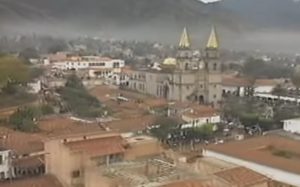 fiesta of the Virgin of Talpa starts sometime at the end of September and ends on the first Sunday of October. This “main event” begins with a large fireworks display to remind the faithful of how the Virgin transformed herself in front of the humble Maria Tenache and the other onlookers on that day in 1644. As is typical in Mexican fiestas, there is a large procession through the town, followed by special masses and celebrations throughout the week. In recent years the town of Talpa has sponsored an arts and crafts show to coincide with the main fiesta week. While the feast days are important, the basilica receives pilgrims throughout the year. Many people who ask for help or give thanks to the Virgin for prayers answered will leave votive offerings of flowers, devotional paintings called retablos, or metal milagro charms. For more information about milagros, please see Mexico Unexplained Episode number one. The Virgin has seen many millions of people in over three and a half centuries and many of these people claim their lives have been completely transformed by prayers to her or just by making the trip to see her. The Virgin of Talpa remains one of the most fascinating, enduring and lesser known miracles of Mexico.
fiesta of the Virgin of Talpa starts sometime at the end of September and ends on the first Sunday of October. This “main event” begins with a large fireworks display to remind the faithful of how the Virgin transformed herself in front of the humble Maria Tenache and the other onlookers on that day in 1644. As is typical in Mexican fiestas, there is a large procession through the town, followed by special masses and celebrations throughout the week. In recent years the town of Talpa has sponsored an arts and crafts show to coincide with the main fiesta week. While the feast days are important, the basilica receives pilgrims throughout the year. Many people who ask for help or give thanks to the Virgin for prayers answered will leave votive offerings of flowers, devotional paintings called retablos, or metal milagro charms. For more information about milagros, please see Mexico Unexplained Episode number one. The Virgin has seen many millions of people in over three and a half centuries and many of these people claim their lives have been completely transformed by prayers to her or just by making the trip to see her. The Virgin of Talpa remains one of the most fascinating, enduring and lesser known miracles of Mexico.
REFERENCES
State government of Jalisco official website on its municipalities (in Spanish): https://www.jalisco.gob.mx/es/jalisco/municipios/talpa-de-allende
“La Historia de la Virgen de Talpa” film series (in Spanish)

2 thoughts on “Our Lady of Talpa, Virgin of Many Miracles”
There was a chapel in honor of Nuestra Señora de Talpa built c. 18roth 38 in northern New Mexico, but its adobe structure fell into complete disrepair by the early 1960s because of family squabbling and lack of car. The artistic and architectural importance of the chapel is captured in a book by William Wroth published by the Taylor Museum of Colorado Springs, Colorado. There have been efforts to restore the chapel, and are again proceeding in spite of difficulties.
I have that same book and fascinated by the little chapel since living here in NM. Plus fascinated of the devotion originating in Mexico.